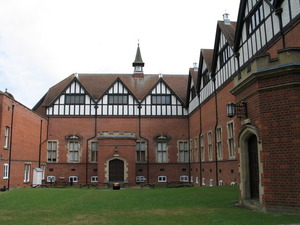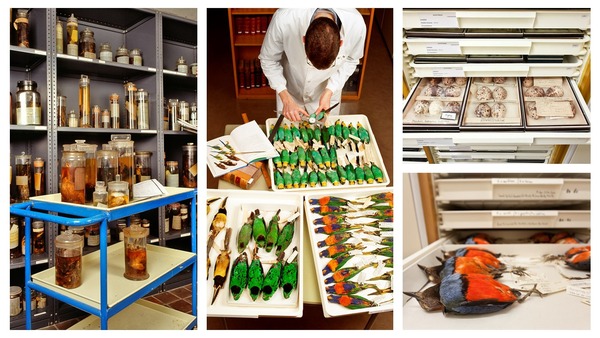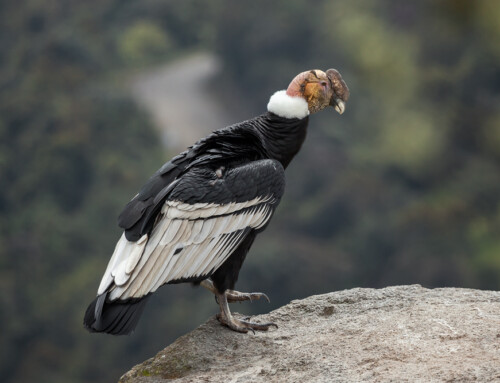 LINKED PAPER
LINKED PAPER
Unlocking avian museum collections to enable and advance environmental change research. Norris, K., Bond, A.L., Cooper, J.H., Adams, M.P., van Grouw, H., White, J., Stervander, M., Russell, D.G.D., Loader, S.P. 2023 Ibis. DOI: 10.1111/ibi.13271 VIEW
Natural history museums and herbariums across the world have over 1.1 billion specimens, yet only 16% of these are digitally discoverable (Johnson et al. 2023). In the UK, there are more than 130 million specimens held in over 90 institutions and if you visit the bird collections at the Natural History Museum in Tring, UK you will see drawers and jars of specimens – skins, skeletons, nests, eggs and whole specimens in spirit or alcohol.

Figure 1 Avian collections at the Natural History Museum, UK. Specimens preserved in spirit or alcohol (left), skins being measured (centre), eggshells (top right) and skins showing the labels (bottom right). © The Trustees of the Natural History Museum, London.
In fact, there are over one million specimens, representing 95% of extant bird taxa making it one of the largest and most comprehensive collection in the world. That’s an awful lot of dead stuff! But how can this historical material support present day efforts to conserve wild birds and the communities they are part of?
Avian museum collections and their associated literature provide a unique perspective on changes in populations and communities through time. The specimens at Tring were collected between the mid-1700s and today, and hence represent a period of rapid environmental change driven by human activities. Each specimen is a potentially rich repository of data relating to the individual animal and the environment it experienced while it was alive and hence provides insights into past environments that can no longer be sampled.
How have researchers used these data to study environmental change?
The list of applications is rather long! It includes studies on egg–shell thinning and exposure to pollutants more generally, geographical range shifts, historical baselines to aid conservation planning, changes in breeding phenology, functional, trophic and host-parasite relationships, climate change, conservation genomics and more.
The important point is that avian collections are potentially relevant to any issue for which insights from the past helps us understand how and why bird populations and communities are changing. Given this relevance, why aren’t we making better use of collections data in environmental change research?
The problem is the data must be created and shared before they can be used for research. In museum jargon, collections need to be ‘unlocked’. Digitisation is the process through which a digital object (data) is created (unlocked) from a physical specimen. Each specimen has a written record associated with it, for example, a label or index card. Digitisation involves transcribing the written record and creating a database similar to a catalogue of library books. This enables specimens to be ‘discovered’ online, which is very useful for research planning purposes, and the data, particularly when and where a specimen was collected, have direct research value. For some research questions, however, additional processes are required for data creation such as high–resolution imaging, chemical analysis or genomic approaches. So, why don’t we simply create the data we need and share it with researchers?
The short answer is cost. From our own pilot work, we estimate that digitising our avian collections to a level that would make individual specimens discoverable would cost approximately £4 million, or on average £3-4 per specimen. This includes not only the data creation, but ensuring the collections are “digital-ready” with modern taxonomic determinations, country-level localities, and collections registration numbers, plus checking the accuracy of the data after it’s been created. Creating additional data through imaging, chemical analysis or genomic approaches would be an additional cost depending on the processes, preparation types and the number of specimens involved. Given most collections-based institutions, including the Natural History Museum UK, would be unable to afford this level of investment from their core funding, additional resources for digitisation will need to be found. This requires a convincing case to be made to organisations or individuals who might provide financial or other support.
A key part of this is to be able to show that there is demand for collections data from the research community, and that any investment in creating data is likely to facilitate a significant increase in research activity.
As a collections-based institution, we have a rather patchy understanding of the needs and interests of the wider research community. We can track the research interests of visitors to our collections and research outputs that cite our collections or data, but these represent a biased sample. Existing studies are constrained by collections data in the public domain, the resources available to researchers to create collections-based data from scratch, and the connections between researchers and curators that are critical to designing and implementing research projects involving collections. We have few insights into the part of the research community that might like to use collections-based data but who currently do not for whatever reason.
This is why we need your help!
The UK Natural Science Collection Community, coordinated by the Natural History Museum, London, and supported by the Arts and Humanities Research Council, are leading a national programme of digitisation called DiSSCo UK to unlock this valuable national resource to the world. This new approach builds on the efforts of individual digitisation approaches of institutions like Kew and has an overall ambition to form a global collection comprised of all the collections of all the world’s museums.
We’d like to hear about your research, specifically the role avian collections and collections data play or might play in your work. We’d also like to hear about why you don’t use our collections in your work.
Do you already use avian collections in your research? If so, what sort of research questions do collections help you answer? Would you like to use collections, but have little idea how to access them or what research might be possible? Do you download and use data from our bird collections that are publicly available online? Are there new data you’d like us to create? If we did, what research would it enable you to do? We need your input to help us understand how we cansupport your work more effectively!
To capture this information, we’ve put together a short research users survey (https://forms.office.com/e/VM9Ui8F8FJ). It doesn’t take long to complete, but the information it provides will be critical for us to plan our next steps. We’d like to hear from anyone who’s engaged in avian research in some way. If you have a view, we’d like to hear it! We will ultimately use the information from the survey to plan our digitisation activities and importantly build a better case to funders to support digitisation and data sharing. We will report the results of the survey back to youand explain our plans through this blog. This represents a unique opportunity for the avian research community in its broadest sense to come together and shape how we make better use of one of our most important research assets – our avian collections – and ultimately help protect the birds we all love!
The Museum needs You! Please help us unlock our collections.
References
Johnson, K.R., Owens, I.F.P., The Global Collections Group. 2023. A global approach for natural history museum collections. Science 379:1192-1194. VIEW
Image credit
Top right:
Natural History Museum Tring, UK © Ian Petticrew CC BY-SA 2.0 Geograph.
If you want to write about your research in #theBOUblog, then please see here.




